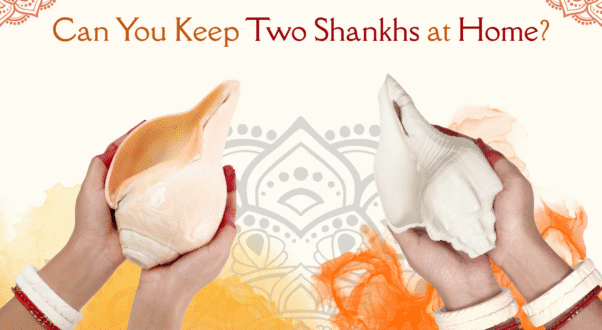
Shankh Blowing as Pranayama: Wellness, Mental Clarity & Stress Relief
The sacred Shankh has been an integral part of Indian culture & spirituality for centuries. It’s not only found in temples, homes and yoga traditions as more than a religious symbol, as it’s a natural instrument to control breath, healing and energy balance. Shankh Blowing as Pranayama becomes a powerful wellness practice that eventually enhances physical vitality, emotional balance and mental clarity.
The Science Behind Shankh Blowing
The blowing of Shankh is merely a ritual—that’s a form of controlled breathing, which engages the lungs, diaphragm and throat muscles. It’s precisely a rhythmic process, mirrors of Pranayama, where the breath is consciously regulated to harmonise the body and mind.
When Shankh is blown, it produces a deep, resonating sound that vibrates the entire body. The vibes stimulate the parasympathetic nervous system. Thus eventually helps calm the mind and reduces stress. The ancient yogic texts say cosmic sounds and vibrations help in deep healing and balancing the life force by cutting the alignment between the physical and subtle bodies.
The resonant frequency of the original Shankh sound is believed to cleanse the aura, purify the surroundings and elevate the mood. It’s within low-frequency vibrations that heal and relax muscles, slow down the heart rate and promote deeper breathing. It’s all the key indicators that help in reducing stress and improving focus.
Correct Method of Blowing Shankh
That sounds simpler, but still, there is a correct method of blowing Shankh—as needed, awareness, breath control and technique. The step-by-step guide is below;
Choose the Right Shankh:
Go for the original conch shell—majorly a Dakshinavarti or Vamavartii Shankh, depending on the tradition and needs you have. It is imperative to ensure it is clean and not damaged or cracked—to produce a steady cosmic sound.
Sit in the Right Posture:
Next comes the posture—do sit comfortably in a meditative pose such as Padmasana, Vajrasana, or Sukhasana. Keep your spine straight and shoulders relaxed.
Prepare Your Breath:
Deep practice of inhale and exhale works great, as it allows the lungs to expand fully. Keep the lips gently closed or pressed against the mouth of the Shankh.
Exhale with Steady Force:
Do blow into the Shankh slowly but firmly, using the diaphragm, but not the cheeks. The blowing generates a sound that is long, stable and continuous—not abrupt or forced.
Focus on the Vibration:
Check and feel the vibrations produced as they will spread through the chest, head and abdomen. This eventually resonance—clears the energetic blockages and promotes mindfulness.
Repeat and Rest:
Do perform this 3-5 times a week, with short pauses in between. Better is to avoid overexerting—especially if you are new to breathwork.
With regular practice, Shankh blowing as Pranayama improves lung strength, boosts oxygen intake, and enhances your ability to control breath—key components of any advanced yogic discipline.
Shankh Benefits for Body and Mind
The benefits of blowing Shankh are far beyond the ritual. Its holistic wellness practice—that majorly influences every system of the body.
Strengthens the Respiratory System
The Shankh blowing expands the lungs and diaphragm, which improves lung capacity. It even promotes oxygen efficiency, which is beneficial for people suffering from asthma or weak respiratory muscles.
Enhances Vocal Clarity
Shankh blowing strengthens the throat muscles and vocal cords, which help in controlled breathwork. Singers, public speakers, and spiritual practitioners often use it to improve voice projection and tone.
Promotes Mental Clarity and Focus
The deep cosmic sound and vibrations of Original Shankh Sound induce a meditative state. It relaxes the mind, improves concentration and promotes inner stillness. It’s similar to the effects of mantra chanting or deep meditation.
Relieves Stress and Anxiety
The sound waves impact relaxation responses to the brain. As stress hormones decrease, it lets you experience calmness. It even helps in reducing blood pressure and a sense of emotional grounding.
Balances Energy and Chakras
The Shankh vibrations also activate the Vishuddha Chakra (throat energy centre). It helps release the suppressed emotions and communication blocks. It also harmonises energy flow through other chakras.
Cleanses the Environment
The significance of Shankh at home extends beyond personal wellness. The cosmic sound purifies the environment, drives away negative energies and invites positivity. It even delivers divine vibrations into space. This is why conch blowing is an essential part of Hindu rituals, temple ceremonies, and morning prayers.
Spiritual and Energetic Importance of Shankh at Home
The importance of Shankh at home lies in its spiritual symbolism and vibrational energy. A conch shell is all linked with Lord Vishnu and depicts purity, prosperity and auspiciousness in life. The positive sound is said to dispel negativity, cleanse subtle vibrations and invite serenity.
Placing a conch shell in the home or puja area brings harmony and protection. And blowing it every day during the puja ritual is believed to refine the environment with sacred and positive energies.
In Vastu Shastra, the Shankh is considered a positive energy amplifier. It is linked with five elements of the universe—earth, water, fire, air, and ether that balance the home’s energy field. Many practitioners also believe that keeping water in a Shankh overnight and using it for rituals purifies both the mind and body.

Integrating Shankh Blowing into Modern Wellness
In a world where stress has become a daily lifestyle part, traditional practices like Shankh Blowing as Pranayama offer a bridge between spirituality and science. It’s not always a part of religious belief or spirituality, but a ritual that can be practised daily for wellness and mindfulness in routine. Start of as-
- Begin your day by blowing the Shankh three times after meditation or yoga.
- Use it as a grounding technique during stressful days to regulate breath and calm the nervous system.
- Combine it with aromatherapy, sound healing, or chanting to deepen your spiritual experience.
Final Thoughts
Shankh blowing as Pranayama is one of the ancient acts—that is a living testimony to India’s deep understanding of breath, sound and consciousness. The vibrations cleanse the mind, strengthen the body and sanctify the spirit.
From practising the spiritual ritual or a wellness exercise, Shankh blowing heals deeply and begins with a single breath—steady, mindful and full of life. The Shankh isn’t just an instrument of sound, but a symbol of awakening, renewal and balance—that gives a call to return to the rhythm of nature and the harmony within.
FAQs
1. How often should I practice Shankh blowing?
Practising once or twice daily is sufficient. Ideally, do it during early morning or before meditation. Avoid practising immediately after meals or when you’re feeling dizzy.
2. Can anyone blow a Shankh?
Yes, anyone can learn with proper guidance. However, people with respiratory issues, hernia, or high blood pressure should consult a doctor before starting. Gentle practice is key.
3. What is the difference between a decorative and an original Shankh?
Decorative conches are often synthetic or modified for aesthetics. An original Shankh produces a deep, natural sound and holds spiritual significance. For effective Shankh blowing as Pranayama, always choose an authentic, natural conch shell.
Explore insights from Kalari Warriors, blending ancient Kalaripayattu traditions with spiritual craftsmanship to enrich your life and rituals.




